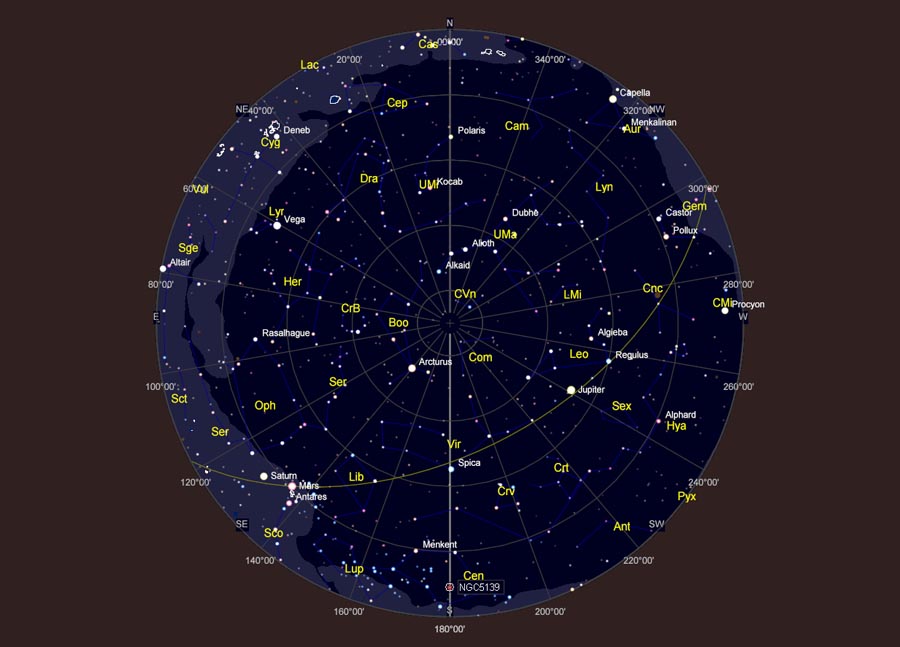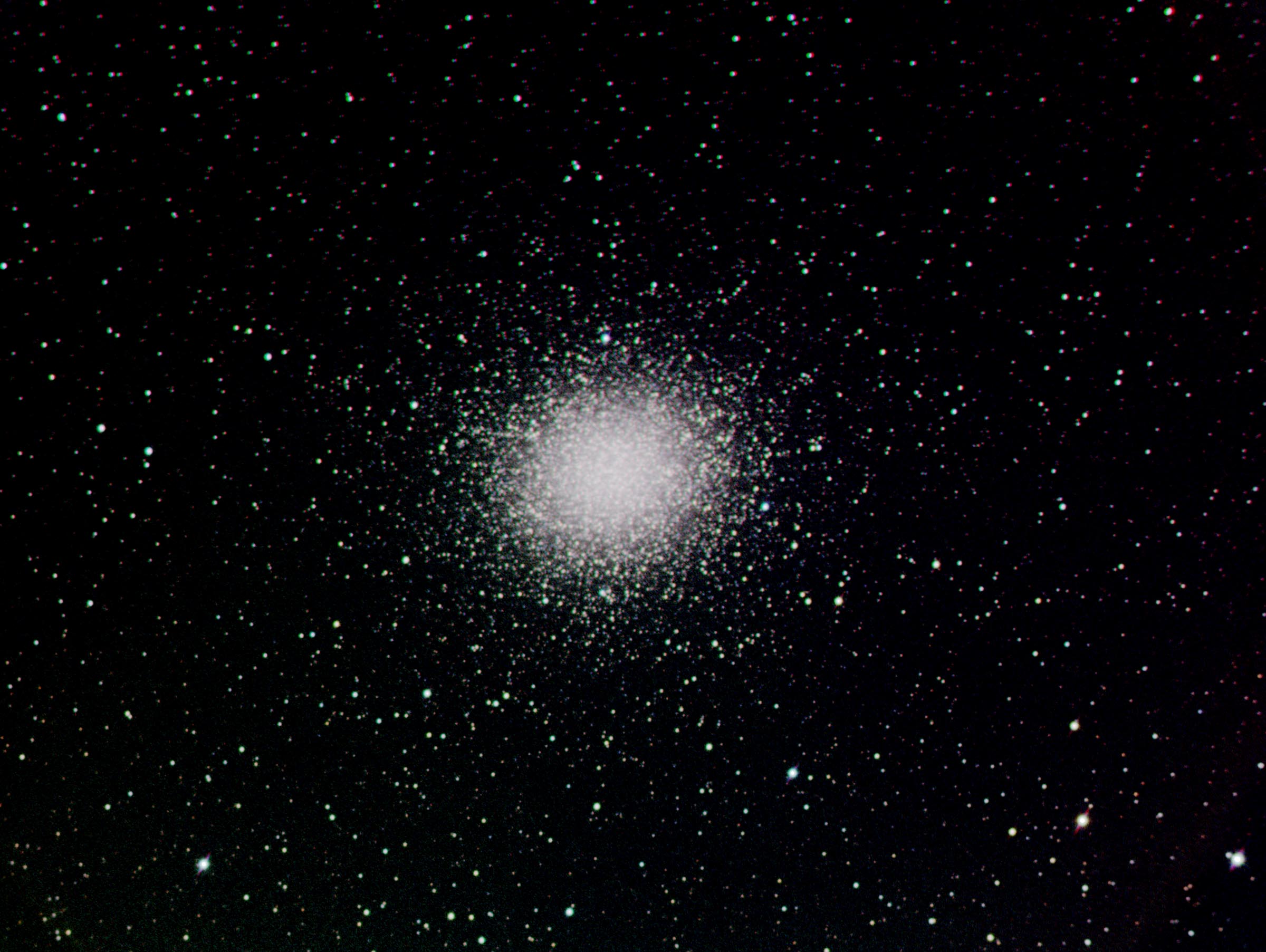
 | SOCO Blog |
28 April 2016
OMEGA CENTAURI
In the last Blog entry, I presented imagery for a trio of spectacular globular clusters (M 3, M 5 and M 13) that grace the late Spring sky. These clusters are located high in the sky and are easily visible to all observers in North America. However, there is one globular cluster in the Spring sky that outshines the others— NGC 5139, commonly known as Omega Centauri. This common name refers to the fact that, at a visual magnitude of 3.9, this cluster was bright enough to be classified as a "star" by early astronomers. In 150 AD, Ptolemy catalogued it as a star in his publication the Almagest. The German Johann Bayer was the one who designated it as the star ω in his 1603 publication of Uranometria (it was the practice of early chart-makers to designate the brighter stars in a constellation using Greek letters). The Englishman Edmund Halley, making telescopic observations from the southern island of St. Helena in 1677, was the first to note that this object was not a single star but a "luminous patch". While both De Cheseaux and Lacaille included it in thieir lists of "nebulous objects", it was the Scottish astronomer James Dunlop in 1826 who first recognized this object as a cluster of stars.
The main problem with observing NGC 5139 in the Spring sky is, depending upon your latitude, is it even in the sky? Figure 1 shows the position of NGC 5139 in the sky at culmination (when it is highest above the horizon) on the night I obtained my imagery (27-28 April, 12:48 AM CDT). At the latitude of SOCO (around 34° N), this cluster is only 9 degrees above the horizon at culmination. If there were any obstructions (trees, buildings) on my southern horizon, I probably couldn't even see it! Being this low on the horizon, I only have about an hour to do any imaging of it in a given night.

Figure 1. Omega Centauri (NGC 5139) rides low above the southern horizon.
Source: Cartes du Ciel.
This low elevation of the target above the horizon presents some very serious problems for imaging it. When an object is this close to the horizon, its light has to pass through a lot of atmosphere before it gets to you. The amount of atmosphere the light has to pass through is described by a quantity called the "air mass" (X). As I describe in the Image Processing section of this website, X is calculated as a function of how high the object is above the horizon (its "stellar zenith angle"). For an object at 9 degrees above the horizon, X = 6.4. For comparison, X = 1 for an object directly overhead. So, the light from NGC 5139 had to pass through a lot of atmosphere before it got to my imaging camera, and that much atmosphere can have serious effects on the object's brightness and (in particular) color balance. The gases in our atmosphere preferentially scatter blue light (that is why the clear daytime sky is blue) so, for objects near the horizon, a great deal of the blue light can be scattered out before it gets to the camera. Without correction, the imaged object could have an unnatural reddish or greenish color.
In my image processing at SOCO, I correct for atmospheric scattering and absorption. It is built into my automatic image processing program SuperSIAM. The parameters in SuperSIAM that correct the imagery for atmospheric scattering and absorption have been developed from photometric observations of individual stars on many nights. Normally when I collect photometric data, I usually stop when the star gets to around 15-20 degrees above the horizon— because I rarely image objects lower than this. My concern was, how would SuperSIAM handle an object this low on the horizon? Would extrapolating the parameter values down to 9 degrees provide adequate atmospheric correction?
I imaged NGC 5139 on the night of 27 April between the hours of 12:15 and 1:18 AM CDT (before the moon came up). The sky was clear, but shortly before I started imaging, the wind direction swung around from the SW to the SE. South-east winds here at SOCO bring in humidity, and the dewpoint temperature jumped from around 20° F to 40° F as a result of the change in wind direction. Humidity also affects atmospheric scattering and absorption, particularly in the blue wavelengths. So, I was definitely not imaging under the best conditions. In the imaging session, I acquired twenty 1-minute exposures in each of the red, green and blue spectral bands— this barely fit in to the 1-hour period that NGC 5139 could adequately be imaged at my site. Prior to processing, I had to throw out some of the images because they weren't as sharp as I wanted— another problem with imaging objects close to the horizon. The remaining images were submitted to SuperSIAM for correction and then used to create a color composite image for NGC 5139.
The resulting color composite image is presented in Figure 2. I was very pleased (and a bit surprised) with how well SuperSIAM corrected the color balance of the imagery— there were no overt greenish or reddish color casts to the object as I would expect with inadequate atmospheric correction. Comparing this image to the previously acquired image of M 13, I could detect that the image of NGC 5139 in Figure 2 appeared to be slightly greener than the image of M 13. To bring the image of NGC 5139 in line with the image of M 13, I used Photoshop to add small amounts of red and blue to the image so that the color balance for NGC 5139 matched that of M 13. The resulting adjusted image of NGC 5139 is presented in Figure 3.

Figure 2. Initial color composite image of Omega Centauri (NGC 5139) resulting from the application of SuperSIAM.

Figure 3. Color composite image of Omega Centauri (NGC 5139) after slight adjustment of the color balance using Photoshop.
As you can see, there is not a lot of difference between Figure 2 and Figure 3. Even when SuperSIAM was pushed beyond the limits for which it was set up, it did a remarkably good job of correcting for an extreme amount of atmospheric scattering and absorption. This shows that, if the image processing functions are based on sound physical principles and have parameters rigorously evaluated using numerous observations, you can have confidence in their ability to adequately correct for atmospheric effects in producing "true color" renditions of astronomical objects. So, I can concur with the well-known physicist Brian Cox in his statement, "...and that's why I love Physics."
 Return to SOCO Blog Page
Return to SOCO Blog Page
 Return to SOCO Main Page
Return to SOCO Main Page
Questions or comments? Email SOCO@cat-star.org